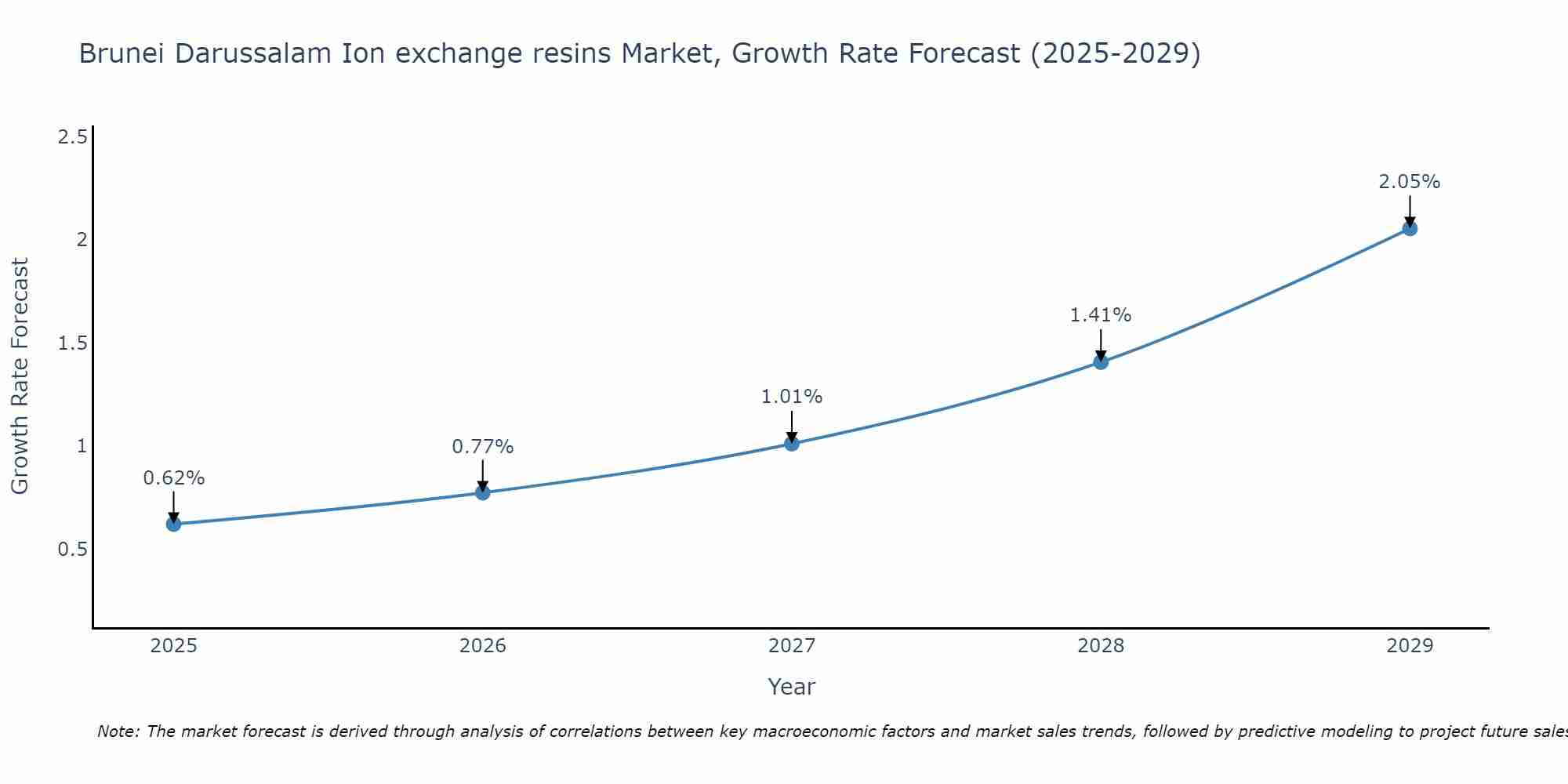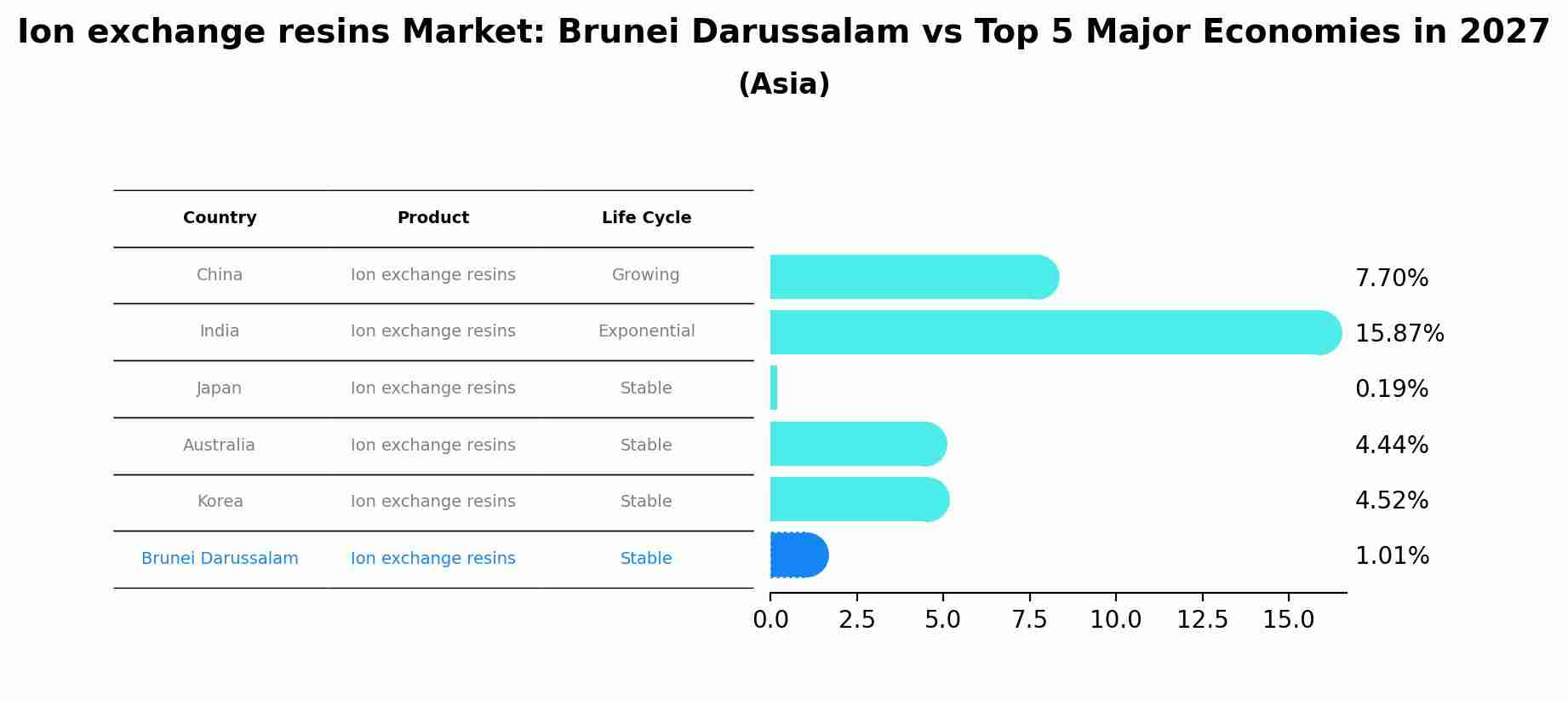Brunei Ion exchange resins Market (2025-2031) | Trends, Share, Industry, Outlook, Analysis, Growth, Revenue, Value, Segmentation, Forecast, Companies & Size
| Product Code: ETC4721111 | Publication Date: Nov 2023 | Updated Date: Apr 2025 | Product Type: Market Research Report | |
| Publisher: 6Wresearch | Author: Shubham Deep | No. of Pages: 60 | No. of Figures: 30 | No. of Tables: 5 |
Brunei Darussalam Ion exchange resins Market Size Growth Rate
The Brunei Darussalam Ion exchange resins Market is likely to experience consistent growth rate gains over the period 2025 to 2029. Commencing at 0.62% in 2025, growth builds up to 2.05% by 2029.

Ion exchange resins Market: Brunei Darussalam vs Top 5 Major Economies in 2027 (Asia)
By 2027, Brunei Darussalam's Ion exchange resins market is forecasted to achieve a stable growth rate of 1.01%, with China leading the Asia region, followed by India, Japan, Australia and South Korea.

Brunei Ion exchange resins Market Overview
The ion exchange resins market in Brunei is expanding as ion exchange resins are used for water purification, chemical processing, and industrial applications. Ion exchange resins are materials that facilitate the exchange of ions between a liquid and a solid, allowing for the removal of impurities and the purification of fluids. The market growth is driven by the increasing demand for clean water, advancements in resin technologies, and the expansion of industrial processes. Innovations in resin formulations and applications are contributing to the development of the ion exchange resins market.
Drivers of the market
The ion exchange resins market in Brunei is expanding due to the increasing demand for water treatment and purification solutions. Ion exchange resins are used to remove impurities and contaminants from water and other liquids, making them essential for applications such as water softening, deionization, and chemical processing. The market`s growth is driven by the rising need for clean and safe water, advancements in resin technologies, and the growing emphasis on environmental sustainability. The increasing adoption of ion exchange resins in various industries and the need for efficient water treatment solutions are significant factors contributing to the expansion of the ion exchange resins market.
Challenges of the market
The Ion Exchange Resins Market in Brunei faces challenges due to the relatively small size of the local water treatment and chemical processing sectors. High production and import costs, combined with limited local manufacturing capabilities, hinder market growth. Additionally, competition from alternative water treatment technologies and fluctuating demand from various industries affect market stability. The market is also influenced by regulatory requirements and the need for ongoing research and development.
Government Policy of the market
Bruneis government policies for the ion exchange resins market emphasize safety, quality, and environmental impact. Ion exchange resins, used in water treatment and other industrial processes, must meet high standards for performance and safety. The government supports the development and use of these resins through regulatory measures that ensure product quality and minimize environmental impact. Additionally, there is a focus on promoting adherence to international standards and encouraging sustainable practices in resin manufacturing and application.
Key Highlights of the Report:
- Brunei Ion exchange resins Market Outlook
- Market Size of Brunei Ion exchange resins Market, 2024
- Forecast of Brunei Ion exchange resins Market, 2031
- Historical Data and Forecast of Brunei Ion exchange resins Revenues & Volume for the Period 2021-2031
- Brunei Ion exchange resins Market Trend Evolution
- Brunei Ion exchange resins Market Drivers and Challenges
- Brunei Ion exchange resins Price Trends
- Brunei Ion exchange resins Porter`s Five Forces
- Brunei Ion exchange resins Industry Life Cycle
- Historical Data and Forecast of Brunei Ion exchange resins Market Revenues & Volume By Type for the Period 2021-2031
- Historical Data and Forecast of Brunei Ion exchange resins Market Revenues & Volume By Cationic Resins for the Period 2021-2031
- Historical Data and Forecast of Brunei Ion exchange resins Market Revenues & Volume By Anionic Resins for the Period 2021-2031
- Historical Data and Forecast of Brunei Ion exchange resins Market Revenues & Volume By Others for the Period 2021-2031
- Historical Data and Forecast of Brunei Ion exchange resins Market Revenues & Volume By Application for the Period 2021-2031
- Historical Data and Forecast of Brunei Ion exchange resins Market Revenues & Volume By Water for the Period 2021-2031
- Historical Data and Forecast of Brunei Ion exchange resins Market Revenues & Volume By Non-water for the Period 2021-2031
- Historical Data and Forecast of Brunei Ion exchange resins Market Revenues & Volume By End-use Industry for the Period 2021-2031
- Historical Data and Forecast of Brunei Ion exchange resins Market Revenues & Volume By Power for the Period 2021-2031
- Historical Data and Forecast of Brunei Ion exchange resins Market Revenues & Volume By Chemical & Petrochemical for the Period 2021-2031
- Historical Data and Forecast of Brunei Ion exchange resins Market Revenues & Volume By Food & Beverage for the Period 2021-2031
- Historical Data and Forecast of Brunei Ion exchange resins Market Revenues & Volume By Pharmaceutical for the Period 2021-2031
- Historical Data and Forecast of Brunei Ion exchange resins Market Revenues & Volume By Electrical & Electronics for the Period 2021-2031
- Historical Data and Forecast of Brunei Ion exchange resins Market Revenues & Volume By Metal & Mining for the Period 2021-2031
- Historical Data and Forecast of Brunei Ion exchange resins Market Revenues & Volume By Others for the Period 2021-2031
- Brunei Ion exchange resins Import Export Trade Statistics
- Market Opportunity Assessment By Type
- Market Opportunity Assessment By Application
- Market Opportunity Assessment By End-use Industry
- Brunei Ion exchange resins Top Companies Market Share
- Brunei Ion exchange resins Competitive Benchmarking By Technical and Operational Parameters
- Brunei Ion exchange resins Company Profiles
- Brunei Ion exchange resins Key Strategic Recommendations
Frequently Asked Questions About the Market Study (FAQs):
1 Executive Summary |
2 Introduction |
2.1 Key Highlights of the Report |
2.2 Report Description |
2.3 Market Scope & Segmentation |
2.4 Research Methodology |
2.5 Assumptions |
3 Brunei Ion exchange resins Market Overview |
3.1 Brunei Country Macro Economic Indicators |
3.2 Brunei Ion exchange resins Market Revenues & Volume, 2021 & 2031F |
3.3 Brunei Ion exchange resins Market - Industry Life Cycle |
3.4 Brunei Ion exchange resins Market - Porter's Five Forces |
3.5 Brunei Ion exchange resins Market Revenues & Volume Share, By Type, 2021 & 2031F |
3.6 Brunei Ion exchange resins Market Revenues & Volume Share, By Application, 2021 & 2031F |
3.7 Brunei Ion exchange resins Market Revenues & Volume Share, By End-use Industry, 2021 & 2031F |
4 Brunei Ion exchange resins Market Dynamics |
4.1 Impact Analysis |
4.2 Market Drivers |
4.3 Market Restraints |
5 Brunei Ion exchange resins Market Trends |
6 Brunei Ion exchange resins Market Segmentations |
6.1 Brunei Ion exchange resins Market, By Type |
6.1.1 Overview and Analysis |
6.1.2 Brunei Ion exchange resins Market Revenues & Volume, By Cationic Resins, 2021-2031F |
6.1.3 Brunei Ion exchange resins Market Revenues & Volume, By Anionic Resins, 2021-2031F |
6.1.4 Brunei Ion exchange resins Market Revenues & Volume, By Others, 2021-2031F |
6.2 Brunei Ion exchange resins Market, By Application |
6.2.1 Overview and Analysis |
6.2.2 Brunei Ion exchange resins Market Revenues & Volume, By Water, 2021-2031F |
6.2.3 Brunei Ion exchange resins Market Revenues & Volume, By Non-water, 2021-2031F |
6.3 Brunei Ion exchange resins Market, By End-use Industry |
6.3.1 Overview and Analysis |
6.3.2 Brunei Ion exchange resins Market Revenues & Volume, By Power, 2021-2031F |
6.3.3 Brunei Ion exchange resins Market Revenues & Volume, By Chemical & Petrochemical, 2021-2031F |
6.3.4 Brunei Ion exchange resins Market Revenues & Volume, By Food & Beverage, 2021-2031F |
6.3.5 Brunei Ion exchange resins Market Revenues & Volume, By Pharmaceutical, 2021-2031F |
6.3.6 Brunei Ion exchange resins Market Revenues & Volume, By Electrical & Electronics, 2021-2031F |
6.3.7 Brunei Ion exchange resins Market Revenues & Volume, By Metal & Mining, 2021-2031F |
7 Brunei Ion exchange resins Market Import-Export Trade Statistics |
7.1 Brunei Ion exchange resins Market Export to Major Countries |
7.2 Brunei Ion exchange resins Market Imports from Major Countries |
8 Brunei Ion exchange resins Market Key Performance Indicators |
9 Brunei Ion exchange resins Market - Opportunity Assessment |
9.1 Brunei Ion exchange resins Market Opportunity Assessment, By Type, 2021 & 2031F |
9.2 Brunei Ion exchange resins Market Opportunity Assessment, By Application, 2021 & 2031F |
9.3 Brunei Ion exchange resins Market Opportunity Assessment, By End-use Industry, 2021 & 2031F |
10 Brunei Ion exchange resins Market - Competitive Landscape |
10.1 Brunei Ion exchange resins Market Revenue Share, By Companies, 2024 |
10.2 Brunei Ion exchange resins Market Competitive Benchmarking, By Operating and Technical Parameters |
11 Company Profiles |
12 Recommendations | 13 Disclaimer |
- Single User License$ 1,995
- Department License$ 2,400
- Site License$ 3,120
- Global License$ 3,795
Search
Thought Leadership and Analyst Meet
Our Clients
Related Reports
- Germany Breakfast Food Market (2026-2032) | Industry, Share, Growth, Size, Companies, Value, Analysis, Revenue, Trends, Forecast & Outlook
- Australia Briquette Market (2025-2031) | Growth, Size, Revenue, Forecast, Analysis, Trends, Value, Share, Industry & Companies
- Vietnam System Integrator Market (2025-2031) | Size, Companies, Analysis, Industry, Value, Forecast, Growth, Trends, Revenue & Share
- ASEAN and Thailand Brain Health Supplements Market (2025-2031) | Strategy, Consumer Insights, Analysis, Investment Trends, Opportunities, Growth, Size, Share, Industry, Revenue, Segments, Value, Segmentation, Supply, Forecast, Restraints, Outlook, Competition, Drivers, Trends, Demand, Pricing Analysis, Competitive, Strategic Insights, Companies, Challenges
- ASEAN Bearings Market (2025-2031) | Strategy, Consumer Insights, Analysis, Investment Trends, Opportunities, Growth, Size, Share, Industry, Revenue, Segments, Value, Segmentation, Supply, Forecast, Restraints, Outlook, Competition, Drivers, Trends, Demand, Pricing Analysis, Competitive, Strategic Insights, Companies, Challenges
- Europe Flooring Market (2025-2031) | Outlook, Share, Industry, Trends, Forecast, Companies, Revenue, Size, Analysis, Growth & Value
- Saudi Arabia Manlift Market (2025-2031) | Outlook, Size, Growth, Trends, Companies, Industry, Revenue, Value, Share, Forecast & Analysis
- Uganda Excavator, Crane, and Wheel Loaders Market (2025-2031) | Strategy, Consumer Insights, Analysis, Investment Trends, Opportunities, Growth, Size, Share, Industry, Revenue, Segments, Value, Segmentation, Supply, Forecast, Restraints, Outlook, Competition, Drivers, Trends, Demand, Pricing Analysis, Competitive, Strategic Insights, Companies, Challenges
- Rwanda Excavator, Crane, and Wheel Loaders Market (2025-2031) | Strategy, Consumer Insights, Analysis, Investment Trends, Opportunities, Growth, Size, Share, Industry, Revenue, Segments, Value, Segmentation, Supply, Forecast, Restraints, Outlook, Competition, Drivers, Trends, Demand, Pricing Analysis, Competitive, Strategic Insights, Companies, Challenges
- Kenya Excavator, Crane, and Wheel Loaders Market (2025-2031) | Strategy, Consumer Insights, Analysis, Investment Trends, Opportunities, Growth, Size, Share, Industry, Revenue, Segments, Value, Segmentation, Supply, Forecast, Restraints, Outlook, Competition, Drivers, Trends, Demand, Pricing Analysis, Competitive, Strategic Insights, Companies, Challenges
Industry Events and Analyst Meet
Whitepaper
- Middle East & Africa Commercial Security Market Click here to view more.
- Middle East & Africa Fire Safety Systems & Equipment Market Click here to view more.
- GCC Drone Market Click here to view more.
- Middle East Lighting Fixture Market Click here to view more.
- GCC Physical & Perimeter Security Market Click here to view more.
6WResearch In News
- Doha a strategic location for EV manufacturing hub: IPA Qatar
- Demand for luxury TVs surging in the GCC, says Samsung
- Empowering Growth: The Thriving Journey of Bangladesh’s Cable Industry
- Demand for luxury TVs surging in the GCC, says Samsung
- Video call with a traditional healer? Once unthinkable, it’s now common in South Africa
- Intelligent Buildings To Smooth GCC’s Path To Net Zero


















